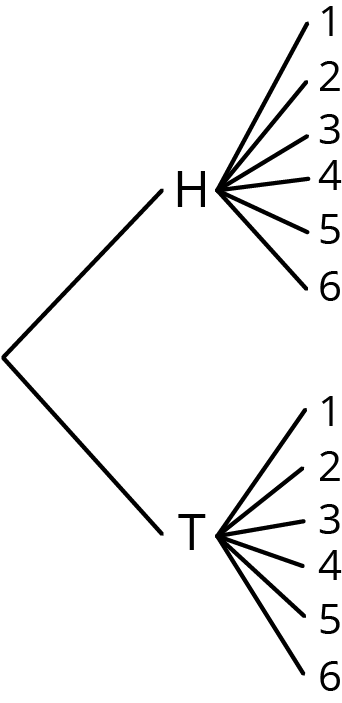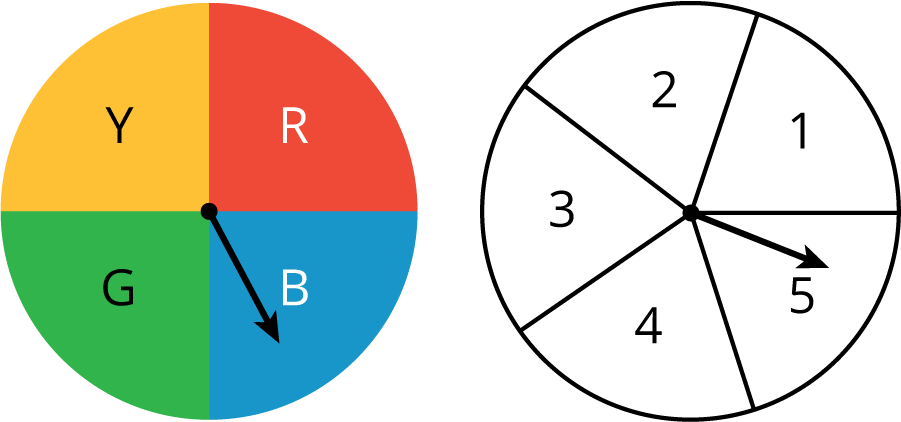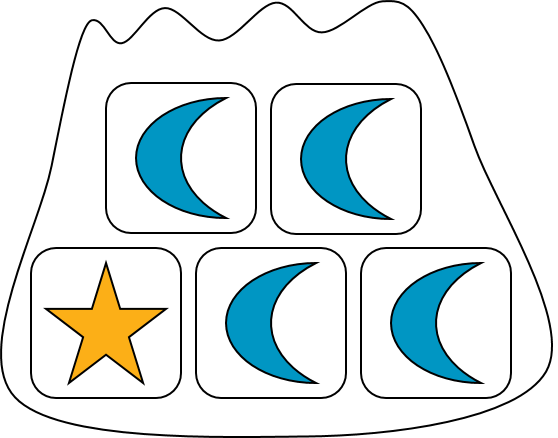Lesson 15
Keeping Track of All Possible Outcomes
Let’s explore sample spaces for experiments with multiple parts.
15.1: How Many Different Meals?
How many different meals are possible if each meal includes one main course, one side dish, and one drink?
| main courses | side dishes | drinks |
|---|---|---|
| grilled chicken | salad | milk |
| turkey sandwich | applesauce | juice |
| pasta salad | — | water |
15.2: Lists, Tables, and Trees
Consider the experiment: Flip a coin, and then roll a number cube.
Elena, Kiran, and Priya each use a different method for finding the sample space of this experiment.
-
Elena carefully writes a list of all the options: Heads 1, Heads 2, Heads 3, Heads 4, Heads 5, Heads 6, Tails 1, Tails 2, Tails 3, Tails 4, Tails 5, Tails 6.
- Kiran makes a table:
| 1 | 2 | 3 | 4 | 5 | 6 | |
|---|---|---|---|---|---|---|
| H | H1 | H2 | H3 | H4 | H5 | H6 |
| T | T1 | T2 | T3 | T4 | T5 | T6 |
-
Priya draws a tree with branches in which each pathway represents a different outcome:

-
Compare the three methods. What is the same about each method? What is different? Be prepared to explain why each method produces all the different outcomes without repeating any.
-
Which method do you prefer for this situation?
Pause here so your teacher can review your work.
-
Find the sample space for each of these experiments using any method. Make sure you list every possible outcome without repeating any.
-
Flip a dime, then flip a nickel, and then flip a penny. Record whether each lands heads or tails up.
-
Han’s closet has: a blue shirt, a gray shirt, a white shirt, blue pants, khaki pants, and black pants. He must select one shirt and one pair of pants to wear for the day.
- Spin a color, and then spin a number.

- Spin the hour hand on an analog clock, and then choose a.m. or p.m.
-
15.3: How Many Sandwiches?
-
A submarine sandwich shop makes sandwiches with one kind of bread, one protein, one choice of cheese, and two vegetables. How many different sandwiches are possible? Explain your reasoning. You do not need to write out the sample space.
- Breads: Italian, white, wheat
- Proteins: Tuna, ham, turkey, beans
- Cheese: Provolone, Swiss, American, none
- Vegetables: Lettuce, tomatoes, peppers, onions, pickles

- Andre knows he wants a sandwich that has ham, lettuce, and tomatoes on it. He doesn’t care about the type of bread or cheese. How many of the different sandwiches would make Andre happy?
-
If a sandwich is made by randomly choosing each of the options, what is the probability it will be a sandwich that Andre would be happy with?
Describe a situation that involves three parts and has a total of 24 outcomes in the sample space.
Summary
Sometimes we need a systematic way to count the number of outcomes that are possible in a given situation. For example, suppose there are 3 people (A, B, and C) who want to run for the president of a club and 4 different people (1, 2, 3, and 4) who want to run for vice president of the club. We can use a tree, a table, or an ordered list to count how many different combinations are possible for a president to be paired with a vice president.
With a tree, we can start with a branch for each of the people who want to be president. Then for each possible president, we add a branch for each possible vice president, for a total of \(3\boldcdot 4 = 12\) possible pairs. We can also start by counting vice presidents first and then adding a branch for each possible president, for a total of \(3 \boldcdot 4 = 12\) possible pairs.

A table can show the same result:
| 1 | 2 | 3 | 4 | |
|---|---|---|---|---|
| A | A, 1 | A, 2 | A, 3 | A, 4 |
| B | B, 1 | B, 2 | B, 3 | B, 4 |
| C | C, 1 | C, 2 | C, 3 | C, 4 |
So does this ordered list:
A1, A2, A3, A4, B1, B2, B3, B4, C1, C2, C3, C4
Glossary Entries
- probability
The probability of an event is a number that tells how likely it is to happen. A probability of 1 means the event will always happen. A probability of 0 means the event will never happen.
For example, the probability of selecting a moon block at random from this bag is \(\frac45\).

- random
Outcomes of a chance experiment are random if they are all equally likely to happen.
- sample space
The sample space is the list of every possible outcome for a chance experiment.
For example, the sample space for tossing two coins is:
heads-heads tails-heads heads-tails tails-tails